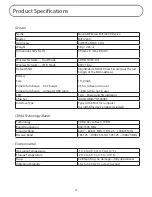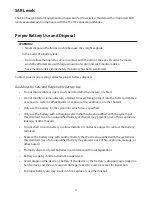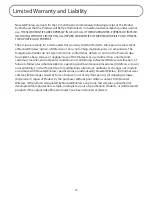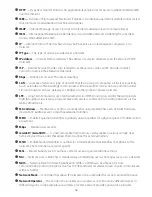
78
●
RTP
— Real-time Transport Protocol. A packet format for streaming multimedia over the Internet.
●
SIM
— Subscriber Identification Module. Found in GSM network technology, the SIM is a card
containing identification information for the subscriber and their account. The SIM card can be moved
to different devices.
●
SMS
— Short Message Service. A service for sending short messages of up to 160 (224 in 5-bit mode)
characters to mobile devices. SMS is also known as text messaging.
●
SMTP
— Simple Mail Transfer Protocol. An Internet standard for email transmission across IP networks.
●
SSID
— Service Set IDentifier. The name assigned to a Wi-Fi network.
●
TCP
— Transmission Control Protocol. A core protocol for transmitting and receiving information over
the Internet.
●
TCP/IP
— Transmission Control Protocol/Internet Protocol. The set of communications protocols used
for the Internet and other similar networks.
●
Telnet
— Telecommunication Network. A network protocol used on the Internet or on local area
networks.
●
TFTP
— Trivial File Transfer Protocol. A file transfer protocol with a subset of FTP functionality.
●
UA
— User Agent. Any device or software used to access a web page. A user agent might be a web
browser, a smart phone, or a screen reader.
●
UDP
— User Datagram Protocol. A simple transport protocol used to transfer information on the
Internet.
●
UI
— User Interface. The part of a software application or hardware device that a user sees and
interacts with.
●
UMTS
— Universal Mobile Telecommunications Service. A third-generation broadband, packet-based
transmission of text, digitized voice, video and multimedia at data rates up to 2 Mbps. UMTS offers
a consistent set of services to mobile users all over the world. UMTS is based on the GSM standard.
Until UMTS is fully implemented, users can use multi-mode devices that switch to currently available
technology.
●
USB
— Universal Serial Bus. A connection type for computing device peripherals such as a printer,
mobile modem, etc. USB connectors may be used for data transfer or charging.
●
USB Port Types
— The USB ports on computers and hubs have a rectangular Type A socket, and
peripheral devices have a cable with a Type A plug. Peripherals that do not have an attached cable
have a square Type B socket on the device and a separate cable with a Type A and Type B plug. Ports
and connectors are available in different sizes (for example, standard, mini, and micro).
●
USSD
— Unstructured Supplementary Service Data. A service found in HSPA/GSM networks that
allows the user to retrieve information or implement certain types of call services.
●
VNC
— Virtual Network Computing. A graphical desktop sharing system that uses the RFB protocol to
remotely control another computer.
●
VPN
— Virtual Private Network. A secure private network that runs over the public Internet. Commonly
used to connect to an office network from elsewhere.
●
VPN Passthrough
— A feature that allows a client to connect to a VPN server.
Содержание MiFi 2200 Comcast
Страница 10: ...2 Using Your MiFi 2200 Device Using Your MiFi Device for the First Time Connect in Wi Fi Mode ...
Страница 19: ...19 make ...
Страница 20: ...20 ...
Страница 33: ...33 Status Wi Fi Status provides you with information about your wireless network ...
Страница 41: ...41 WWAN Status The WWAN Status page displays information about your internet connection ...
Страница 59: ...4 Troubleshooting Overview Common Problems and Solutions Use the Master Reset Button Technical Support ...
Страница 73: ...6 Glossary Glossary ...
















